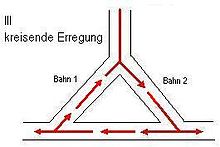Circling excitement
A circulating excitation (English reentry ) is a basal form of the disorder of impulse conduction in the heart . During a normal heart action comes each excitation after activation of the ventricular void because they then only of refractory surrounded, so difficult, if not excitable, tissue is. The excitation can also spread in both directions within the Purkinje fibers and ceases immediately when two impulses meet. If, for example, there is an anatomical or functional obstacle in a bundle of a branching Purkinje fiber, a dangerous intermediate stage can occur before the transition is completely blocked at this point: a unidirectional block .
The damaged area slows the passage of an excitation until it is refractory to the next, i.e. difficult or impossible to excite at all. This excitation can now run through the damaged area in the opposite direction, since it reaches it at a point in time when it may no longer be refractory. If the refractory path that remains behind this retrograde or antidromic excitation (running in the opposite direction) is shorter than the circular path, the excitation within the circle is no longer extinguished and can run through it permanently. One speaks of a circular excitation.
The danger here is a “reentry” of the excitation wave into the surrounding tissue when it is no longer refractory. An excitement can develop which, as it were, entertains itself. This is the cause of severe tachycardiac arrhythmias with the risk of fibrillation .
requirement
According to the equation (see below), the prerequisite is that the circular path must be longer than the associated refractory distance of the potentially circular excitation. This is favored with a reduced refractory period and reduced line speed.
- s r is the refractory distance, which is proportional to the wavelength .
- t r is the refractory period, which is proportional to the potential duration.
- v is the conduction speed, which depends on the number of sodium channels.
Predilection sites for reentry phenomena
- especially the area around the AV area
- accessory AV conduction pathway ( Wolff-Parkinson-White syndrome )
- ventricular acute ischemic zones
- Peripheral zones of all infarcts
Effect of antiarrhythmic drugs on circular excitation
Class Ia antiarrhythmics :
- Extension of the absolute refractory period
- greater reduction in line speed
By increasing the probability of a reduced lambda wavelength with prophylactic long-term administration, there is an increased probability of small reentry circles (up to a minimum of 4 myocardial cells in size) - proarrhythmic .
Class Ib antiarrhythmics :
- hardly any change or reduction in the absolute refractory period
- weak line speed reduction
Preferred reduction in the conduction velocity in partially depolarized tissue compared to healthy tissue (prototype lidocaine ). A circular excitation can thus be broken at the point of a unidirectional block by converting it into a bidirectional block without delaying the conduction of excitation significantly in healthy tissue - slightly proarrhythmic .
Class Ic antiarrhythmics :
- hardly any extension of the absolute refractory period
- strong reduction in line speed
By greatly increasing the likelihood of a reduced lambda wavelength with prophylactic long-term administration, the likelihood of small reentry circles is increased the most - strongly proarrhythmic (see CAST study - Cardiac Arrhythmia Suppression Trial).
Class III antiarrhythmics :
- significant extension of the absolute refractory period
- insignificant change in line speed
Increased refractory periods inevitably lead to longer wavelengths. Lambda can become larger, even larger than the diameter of the heart - slightly proarrhythmic .
literature
- Hans-Peter Schuster, Hans-Joachim Trappe: EKG course for Isabel . Thieme, Stuttgart 2005, ISBN 3-13-127284-8
- Klaus Aktories, Ulrich Förstermann, Franz Hofmann, Wolfgang Forth: General and special pharmacology and toxicology . Urban & Fischer bei Elsevier, November 2004, ISBN 3-437-42521-8




